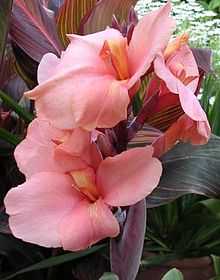Lilioid monocot
Lilioid monocots or lilioids is an informal name used for a grade of five monocot orders (Petrosaviales, Dioscoreales, Pandanales, Liliales and Asparagales) in which the majority of species have flowers with relatively large, coloured tepals, broadly similar to those of lilies. Another name for this group is petaloid monocots, because the flowers have tepals which all resemble petals. In older classification systems, still found in many books and other sources, many of the species in this group of plants were put into a very broadly defined family Liliaceae (lily family). Within the monocots they were distinguished from the Glumaceae.
Flowers
|
lilioid monocots |
The diagram shows a cladogram of the monocots[1] in which the bracket marks the lilioid monocots, namely the orders Petrosaviales, Dioscoreales, Pandanales, Liliales and Asparagales.[2] The lilioid monocots all have flowers which can be considered to have been derived from a lily-like flower with six relatively similar tepals, six stamens, and a superior ovary composed of three carpels, with nectaries at the base. This pattern is primitive (plesiomorphic) for the lilioid monocots. Various trends are apparent among the lilioids, notably a change to an inferior ovary and a reduction of the number of stamens to three. In some groups (such as the genus Trillium in the Liliaceae), the tepals have become clearly differentiated, so that the flower has three coloured petals and three smaller green sepals. Almost all lilioid monocots retain at least three petal-like tepals.[3] Since some commelinids (e.g. Tradescantia) do have petaloid flowers, the term 'lilioid' is a more accurate one for the group which excludes them. In John Lindley's system (1830) they were described as the tribe Petaloideae.[4]

In the orders that branched off before the lilioid monocots, the Acorales and Alismatales, flowers differ in several ways. In some cases, like Acorus, they have become insignificant. In others, like Butomus, they have six coloured tepals, and so could be called 'petaloid', but stamens and carpels are more numerous than in the lilioid monocots.
The later evolved commelinids have various kinds of flower, few of which are 'lily-like'. In the order Poales, comprising grasses, rushes and sedges, flowers are either petal-less or have small, unshowy petals. Many Zingiberales species have brightly coloured and very showy flowers. However, their apparent structure is misleading. For example, the six tepals of cannas are small and hidden under expanded and brightly coloured stamens or staminodes which look like petals, but are not.
The lilioids and classification systems
When classification systems were based on morphological characters, lilioid species which clearly departed from the 'lily' pattern were easily placed into separate families. For example, the Amaryllidaceae contained species whose flowers had six stamens and an inferior ovary. The Iridaceae contained those with three stamens and an inferior ovary. The 'left-overs' were put together in a very broadly defined Liliaceae. (See, for example, the Cronquist system.) With the advent of DNA sequencing and the use of genetic data in determining relationships between species, what many taxonomists had long suspected was confirmed: the old Liliaceae family was highly polyphyletic, comprising a significant number of unrelated groups, which are now placed in quite separate families – and indeed orders, since some genera which were in the old Liliaceae are now placed in different families in the order Asparagales (e.g. Hyacinthus is now in the family Asparagaceae).[1]
The full extent of the changes required to traditional classification systems only become apparent in the 1990s; the system produced by the Angiosperm Phylogeny Group in 1998 represented one of the first attempts at a classification which took into account genetic evidence.[5] Textbooks and other sources produced in the last century are inevitably based on older classifications. Publications using versions of the APG system are now beginning to appear and the influential World Checklist of Selected Plant Families from the Royal Botanic Gardens, Kew is being updated to the APG III system and hence the classification of the lilioid monocots shown in the cladogram above.[6]
References
- ↑ 1.0 1.1 Angiosperm Phylogeny Group III (2009), "An update of the Angiosperm Phylogeny Group classification for the orders and families of flowering plants: APG III", Botanical Journal of the Linnean Society 161 (2): 105–121, doi:10.1111/j.1095-8339.2009.00996.x
- ↑ Royal Botanic Gardens, Kew, Monocots I: General Alismatids & Lilioids, retrieved 2010-12-24
- ↑ Department of Botany, University of Wisconsin-Madison, Diversity and Evolution of Monocots: Lilioids (PDF), retrieved 2010-12-24
- ↑ Lindley 1830.
- ↑ Angiosperm Phylogeny Group (1998), "An ordinal classification for the families of flowering plants", Annals of the Missouri Botanical Garden 85 (4): 531–53, JSTOR 2992015
- ↑ Royal Botanic Gardens, Kew, World Checklist of Selected Plant Families, retrieved 2010-12-24